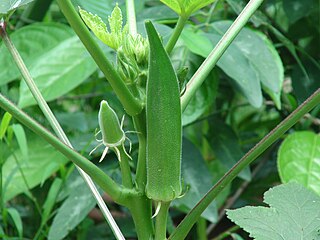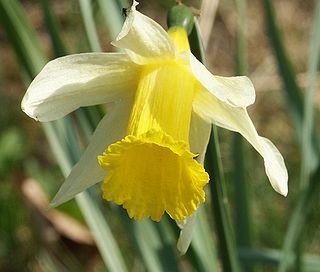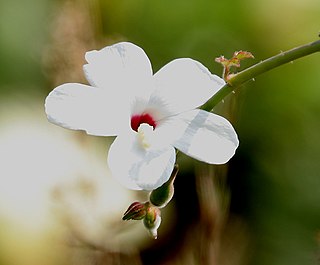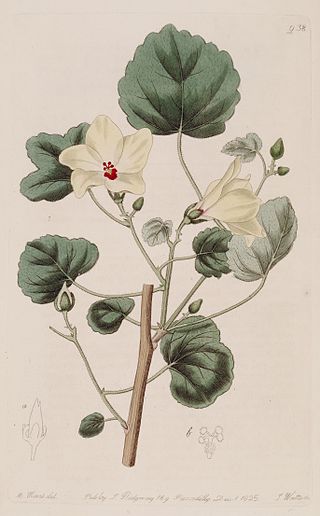Mallow or mallows may refer to:

Musk is a class of aromatic substances commonly used as base notes in perfumery. They include glandular secretions from animals such as the musk deer, numerous plants emitting similar fragrances, and artificial substances with similar odors. Musk was a name originally given to a substance with a strong odor obtained from a gland of the musk deer. The substance has been used as a popular perfume fixative since ancient times and is one of the most expensive animal products in the world. The name originates from the Late Greek μόσχος 'moskhos', from Persian mushk and Sanskrit मुष्क muṣka derived from Proto-Indo-European noun múh₂s meaning "mouse". The deer gland was thought to resemble a scrotum. It is applied to various plants and animals of similar smell and has come to encompass a wide variety of aromatic substances with similar odors, despite their often differing chemical structures and molecular shapes.

Hibiscus is a genus of flowering plants in the mallow family, Malvaceae. The genus is quite large, comprising several hundred species that are native to warm temperate, subtropical and tropical regions throughout the world. Member species are renowned for their large, showy flowers and those species are commonly known simply as "hibiscus", or less widely known as rose mallow. Other names include hardy hibiscus, rose of sharon, and tropical hibiscus.

The Canellaceae are a family of flowering plants in the order Canellales. The order includes only one other family, the Winteraceae. Canellaceae is native to the Afrotropical and Neotropical realms. They are small to medium trees, rarely shrubs, evergreen and aromatic. The flowers and fruit are often red.

Chenopodium is a genus of numerous species of perennial or annual herbaceous flowering plants known as the goosefoot, which occur almost anywhere in the world. It is placed in the family Amaranthaceae in the APG II system; older classification systems, notably the widely used Cronquist system, separate it and its relatives as Chenopodiaceae, but this leaves the rest of the Amaranthaceae polyphyletic. However, among the Amaranthaceae, the genus Chenopodium is the namesake member of the subfamily Chenopodioideae.

Okra, Abelmoschus esculentus, known in some English-speaking countries as lady's fingers, is a flowering plant in the mallow family. It has edible green seed pods. The geographical origin of okra is disputed, with supporters of West African, Ethiopian, Southeast Asian, and South Asian origins. Cultivated in tropical, subtropical, and warm temperate regions around the world, okra is used in the cuisines of many countries.

Hibiscus laevis, the halberd-leaf rosemallow, is a herbaceous perennial flower native to central and eastern North America. Their showy, creamy-white or pink flowers are large, up to 15 centimetres (6 in) across, and are hard to miss. These flowers require exposure to sunlight to open up properly, and then last only a single day.

Narcissus pseudonarcissus, commonly named the wild daffodil or Lent lily, is a perennial flowering plant.

Abelmoschus manihot, commonly known as aibika, is a flowering plant in the family Malvaceae. It was previously classified as a species of Hibiscus but is now categorized under the genus Abelmoschus. This plant is also referred to as the sunset muskmallow, sunset hibiscus, or hibiscus manihot.

Abelmoschus moschatus is an aromatic and medicinal plant in the family Malvaceae native to Asia and Australia.
Abelmoschus caillei, the West African okra, is a plant species in the family Malvaceae. It occurs in humid areas of West and Central Africa, where it is used as a vegetable. It originated as an allopolyploid hybrid of Abelmoschus esculentus and A. manihot, and is often mistaken for either of those two plants. It was officially described elevated to the status of a species in 1988. The same hybrid was produced experimentally in Japan where it is known as Abelmoschus glutino-textile.

George Clifford III was a wealthy Dutch banker and one of the directors of the Dutch East India Company. He is known for his keen interest in plants and gardens.

Hibiscus calyphyllus, the lemonyellow rosemallow, is a shrub from tropical Africa belonging to the genus Hibiscus. In 1883 this Hibiscus was offered for sale in England under the name Hibiscus chrysanthus with Port Natal, Cape Colony, identified as the source. By 1891 the same Hibiscus was identified as Hibiscus chrysantha in the United States, a practice which may have continued into the 1930s and contributed to incorrect species identification. In 1892 the name Hibiscus calycinus was designated as the correct name for the species; but, by 1894 the currently accepted name Hibiscus calyphyllus is found in association with Hibiscus calycinus. At the beginning of the 20th century, this Hibiscus was sold as seeds in the United States under the name Hibiscus Giant Yellow. Because of the similarity of the flowers, it is quite common to find Abelmoschus manihot confused with Hibiscus calyphyllus in the early 20th century gardening literature of the United States, particularly in the area of cold tolerance. If the species identification is correct, the 1903 report in The Flower Garden states that: "Giant Yellow is a beautiful canary yellow with crimson throat, hardy as far north as St. Louis, but safer in the cellar above that latitude", then Hibiscus calyphyllus may have some degree of cold tolerance. St. Louis, Missouri is in USDA Zone 6a but there are currently no reports of Hibiscus calyphyllus overwintering in USDA Zone 6a; it is known to overwinter successfully in USDA Zone 8a.

Anomis sabulifera, the angled gem or jute semi-looper, is a moth of the family Erebidae. The species was first described by Achille Guenée in 1852. It has a Paleotropical distribution and ranges from Africa eastwards to India, Sri Lanka and Australia. A single record was found from Britain.

Abelmoschus ficulneus is a species of flowering plant in the genus Abelmoschus, family Malvaceae. Commonly known as white wild musk mallow or native rosella, it is fibrous perennial with a woody stem. Its flowers are about an inch in diameter, either pink or white, with a rose center; its leaves are palmate.

Abelmoschus crinitus is a species of flowering plant belonging to the mallow family. It was first described by Nathaniel Wallich in 1830.

Dysdercus cingulatus is a species of true bug in the family Pyrrhocoridae, commonly known as the red cotton stainer. It is a serious pest of cotton crops, the adults and older nymphs feeding on the emerging bolls and the cotton seeds as they mature, transmitting cotton-staining fungi as they do so.

Xanthodes transversa, the transverse moth or hibiscus caterpillar, is a moth of the family Nolidae. The species was first described by Achille Guenée in 1852. It is found in India, Sri Lanka, the Andaman Islands, the Nicobar Islands, China, Hong Kong, Vanuatu, Java, New Guinea, Japan, the Ryukyu Islands, Singapore, Indonesia and Australia.
Oxycarenus laetus, commonly known as the dusky cotton bug, is a species of plant bug belonging to the family Lygaeidae. It is sometimes known as the Egyptian cotton stainer, and is found in southern Asia where it is a pest of cotton, okra and other crops.

Abelmoschus hostilis is a rare species of flowering plant in the Malvaceae family. It is native to Bangladesh and Myanmar and is known as "Kantabhendi" in Bengali.


























